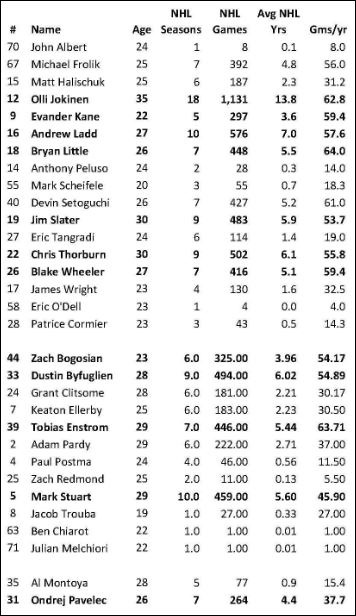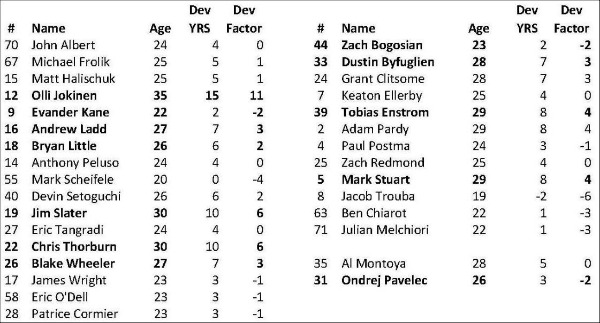Winnipeg Jets And Their Potential Growth Or Has The Core Hit Their Ceiling —
The much maligned Winnipeg Jets continue to go through stretches of good play followed up by stretches of defensive mistakes and lack of offense resulting in more losses. There has been much ado about players such as Ondrej Pavelec and whether he’s the goalie of the future. We’ve heard about coaching, an area I have been critical of for some time, and Claude Noel’s in-game management. We’ve talked ad nauseam about the good Buff and the bad Buff. The passion of the fans and their knowledge of the game is what makes the conjecture interesting and fun. So let’s have a little more fun trying to determine if, as the overused quote says, this team is what we thought they were or a team needing some fundamental change.
In order to do this. you have to look at this roster with a dose of reality and a sip of optimism where warranted. To be objective, I revert back to what I have learned over the years (from listening to the pro’s of course) as to what the typical development period for any player is. Most players need about 4 years of experience or 300-400 NHL games to achieve their potential. In the case of goalies, the learning curve is a little longer. For the purpose of this evaluation, we have used 5 years for goalies. Now, after much internal debate often characterizing players as lacking “intensity”, we thought best not to invite the National Media into our war room for our final reviews. Mitch Kasprick and I will do!
The development years of most players truly start when they hit 20 years old. There are always exceptional players that come into the league and dominate from the get go. Not every team has a Crosby, Ovechkin or Malkin. The stars for most teams have gone through a learning curve to achieve what they now enjoy. So when looking at the Jets, I’ve tried to look at the players in this light. The first piece of data looks at the players age and what I’m calling the Development Factor. In a very simplistic baseline review, you are able to determine if there still is some development time or “Upside” to a player.
Naturally, there are players with a negative (-) Development Factor and others with a positive (+) number attached to their names. The higher the positive (+) Development Factor the less likely that player has any “upside” left. The power of this factor is achieved when you look at the results (goals, assists, points, etc.) that the player has achieved to date. A team could still be young in relative terms yet their upside may have been reached. As an example, John Albert is 24 years of age and theoretically has reached his performance ceiling. John Albert has played very few NHL games and continues to find himself in the AHL. Yes, he’s played a handful of NHL games and one could argue he hasn’t been given a chance to show what he’s got. However, it cannot be dismissed that there must be a reason why, at the age of 24, he hasn’t played more games. According to this assessment tool he will most likely be an AHL players throughout his career.
When you look at the core (highlighted in bold) of this team, there are many plus numbers on the Development Factor. When you combine it with the number of NHL games played and statistical performance, it can be assumed they are what they are. Let’s use Andrew Ladd as another example. His Development Factor is +3 and over the last 3+ years Ladd performance has been consistent. The pundits and fans alike know what you’re going to get from Andrew Ladd. The point is not to beat up on Andrew Ladd but to simply ensure you understand the metric.

I’m not suggesting my method is used by professional teams but if they do, it would make some sense. I’m also not suggesting this method is perfect but it is simple and based on tangible information we all know and understand. Conversely, this methodology in no way suggests a player, when they hit their development ceiling, will experience an epiphany and score at rates outside of their normal performance. It’s simply a tool to help evaluate ones future performance all the while maintaining some perspective on expectations. I just realized I’m starting to sound like our friends over at AIH! (not that there’s anything wrong with that) ….. (seinfeldism slipped in by the editor)
When you look at this core, you can see their ceiling has been hit and we as fans should not expect any more than what we get from a Dustin Byfuglien, Toby Enstrom or an Eric Tangradi. They are what we think they are and in that same light the team performance is reflected accordingly. Dustin Byfuglien is an impactful defenseman on the offensive side and can be a liability on the defensive side. That is his game and an expectation for anything else would be wishful thinking. If a player is inconsistent at a certain point in their careers, it is who they are.
Unfortunately, the Winnipeg Jets have too many players on the wrong side of the Development Factor and that may be a harsh reality for the fans. The game plan Chevy has put in place appears to be problematic as he has tied himself to numerous long term contracts with players, based on the above analysis, that have reached their potential. The players are continually trying to get better in hopes of helping the team. They wouldn’t be professionals if they didn’t. However, it is time to manage expectations and realize that this group is NOT a playoff team. In fact, they may not be a playoff team for quite some time. There are too many gaps to fill offensively and defensively. In terms of goaltending, the window is narrowing on Pavelec. Can we expect more growth? Despite taking a step backwards thus far this year, there still may be time for him to reach that elite status.
There are two ways a team can grow; through the draft or through trades and free agency. As it was suggested in a recent article by Winnipeg Sun columnist, Paul Friesen, there is more than one way to achieve Stanley Cup glory. At some point, Kevin Cheveldayoff and his brain trust will have to ask themselves the “Million Dollar Question”. Is this working and can we afford to wait another 5 years before making the playoffs? A dismantling of this team is not what I think should happen but certainly based on this Development Factor changes are required for a team that has not made the playoffs and is continually a .500 hockey team.
*


hopefully those charts show some new blood in the line-up next season. Maybe Kichton or Lowry?
Without a doubt to expect more from this group would contravene the advanced science and in depth analytics contained in these metrics. All kidding aside, the Jets need an infusion of more new blood to change the path of this group. Maybe Lowry and Kitchon. If like to see a young group grow and win together. The current group has not.